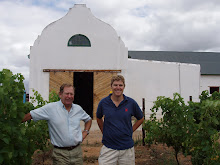
Christmas is that wonderful time of year when you get to eat and drink to your heart’s content. Choosing appropriate wines to match the food is always a challenge, as Christmas in South Africa takes place in the height of summer. We tend to have cold food, and thus you have to choose the wines a bit more carefully.
This year we will start off with some locally produced bubbly. Robertson is slowly getting a very good reputation for the production of Sparkling wine (made in the proper Champagne method). This will be followed by our Sauvignon Blanc and Chardonnay.
Obviously mains will need red. I have found that it is better chilling the wines to 15°C in summer. If you serve them at room temperature, they are normally 25°C, which is far too warm. The wines taste less fruity and more alcoholic. In summer it is also best to serve younger fruitier wines.
The highlight for Christmas this year is a bottle of 1979 Excelsior Muskadel Jerepigo that was given to us recently. Muskadel Jerepigo is a fortified Muscat wine, made in the Beames de Venise style. I have not yet tasted this wine, but generally Muscats do age very well. The wine looks like it is in good condition. We are pairing it with a homemade Green Fig and Port ice cream and hope that we will be pleasantly surprised.
Merry Christmas.




